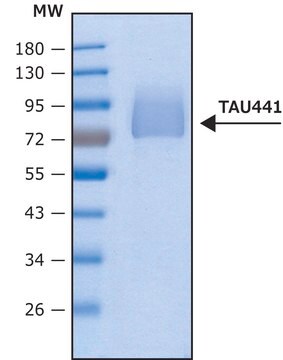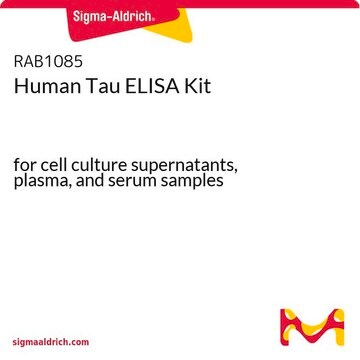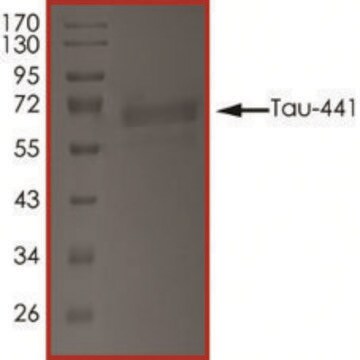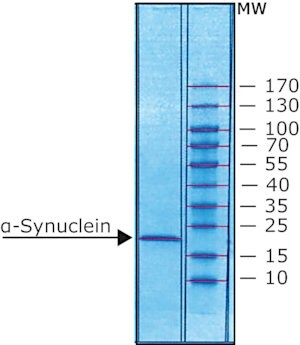Alle Fotos(1)
Wichtige Dokumente
T9950
Tau-352 human
recombinant, expressed in E. coli, ≥90% (SDS-PAGE), lyophilized powder
Synonym(e):
Human Tau Protein
Anmeldenzur Ansicht organisationsspezifischer und vertraglich vereinbarter Preise
Alle Fotos(1)
About This Item
Empfohlene Produkte
Biologische Quelle
human
Qualitätsniveau
Rekombinant
expressed in E. coli
Assay
≥90% (SDS-PAGE)
Form
lyophilized powder
Mol-Gew.
36.8 kDa
UniProt-Hinterlegungsnummer
Anwendung(en)
cell analysis
Versandbedingung
wet ice
Lagertemp.
−20°C
Angaben zum Gen
human ... MAPT(4137)
Anwendung
Tau-352 human is a Tau isoform, variant 0N3R which means it consists of 3 microtubule binding repeats (R) and no amino terminal inserts (N). The product can be utilized for systemic identification of Phosphorylation sites in microtubule-associated protein tau by using checkpoint kinases Chk1 and Chk2 in vitro.
Biochem./physiol. Wirkung
Tau-383 human belongs to neuronal microtubule-associated protein family that stimulates the microtubule assembly and stability as well as facilitates hyperphosphorylation-induced self-assembly into filaments. Tau protein along with src can upregulate tyrosine kinase activity. Inhibition of Src kinase influences the action of tau on actin rearrangements which in turn impacts the growth-factor-induced actin remodeling.
Isoform of Tau, variant 0N3R, having 3 microtubule binding repeats (R) and no amino terminal inserts (N).
Rekonstituierung
Lyophilized from MES, pH 6.8, containing NaCl and EGTA. When reconstituted in water to a protein concentration of 1 mg/mL, the resulting buffer will have ~50 mM MES, pH 6.8, 100 mM NaCl, and 0.5 mM EGTA.
Lagerklassenschlüssel
11 - Combustible Solids
WGK
WGK 1
Flammpunkt (°F)
Not applicable
Flammpunkt (°C)
Not applicable
Persönliche Schutzausrüstung
Eyeshields, Gloves, type N95 (US)
Hier finden Sie alle aktuellen Versionen:
Besitzen Sie dieses Produkt bereits?
In der Dokumentenbibliothek finden Sie die Dokumentation zu den Produkten, die Sie kürzlich erworben haben.
Vandana M Sharma et al.
Journal of cell science, 120(Pt 5), 748-757 (2007-02-08)
The microtubule-associated protein tau interacts with the SH3 domain of non-receptor Src family protein tyrosine kinases. A potential consequence of the SH3 interaction is the upregulation of tyrosine kinase activity. Here we investigated the activation of Src or Fyn by
Jhoana Mendoza et al.
Journal of proteome research, 12(6), 2654-2665 (2013-04-05)
Hyperphosphorylation of microtubule-associated protein tau is thought to contribute to Alzheimer's disease (AD) pathogenesis. We previously showed that DNA damage-activated cell cycle checkpoint kinases Chk1 and Chk2 phosphorylate tau at an AD-related site and enhance tau toxicity, suggesting potential roles
A Himmler et al.
Molecular and cellular biology, 9(4), 1381-1388 (1989-04-01)
Tau proteins consist of a family of proteins, heterogeneous in size, which associate with microtubules in vivo and are induced during neurite outgrowth. In humans, tau is one of the major components of the pathognomonic neurofibrillary tangles in Alzheimer's disease
Jesus Avila et al.
Physiological reviews, 84(2), 361-384 (2004-03-27)
The morphology of a neuron is determined by its cytoskeletal scaffolding. Thus proteins that associate with the principal cytoskeletal components such as the microtubules have a strong influence on both the morphology and physiology of neurons. Tau is a microtubule-associated
M Goedert et al.
Neuron, 3(4), 519-526 (1989-10-01)
We have determined the sequences of isoforms of human tau protein, which differ from previously reported forms by insertions of 29 or 58 amino acids in the amino-terminal region. Complementary DNA cloning shows that the insertions occur in combination with
Artikel
Alzheimer's disease (AD) is the most common cause of dementia in the elderly and is characterized by gradual loss of cognitive functions.
Unser Team von Wissenschaftlern verfügt über Erfahrung in allen Forschungsbereichen einschließlich Life Science, Materialwissenschaften, chemischer Synthese, Chromatographie, Analytik und vielen mehr..
Setzen Sie sich mit dem technischen Dienst in Verbindung.






